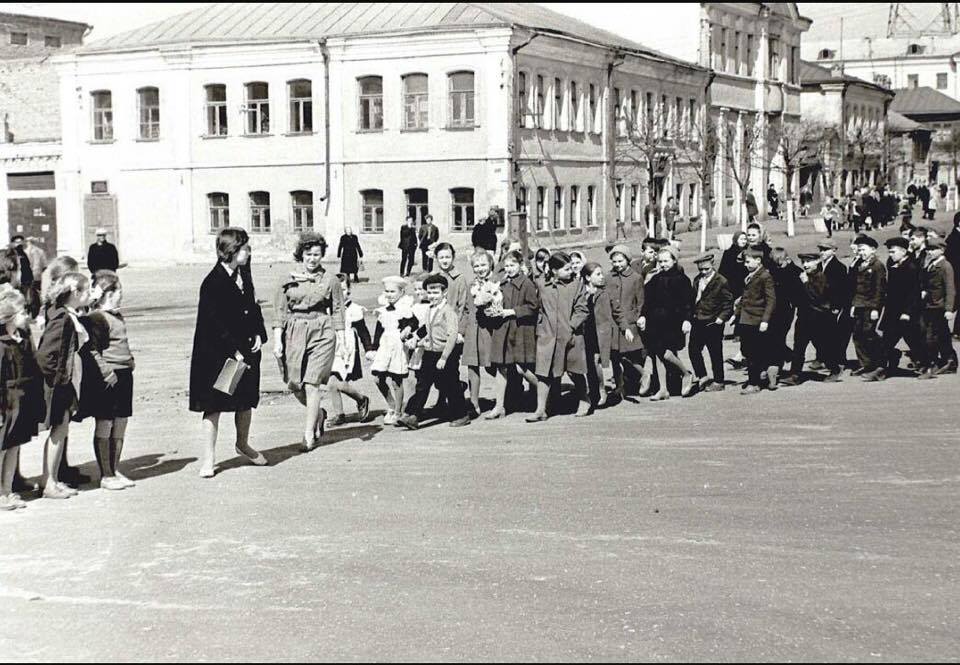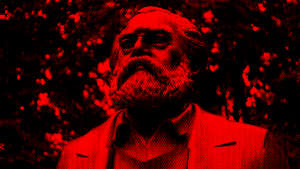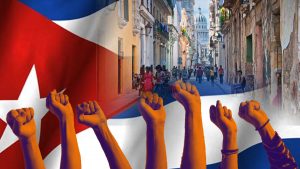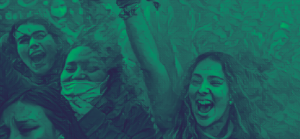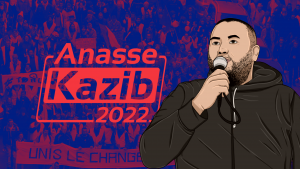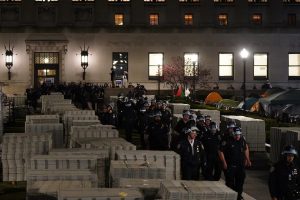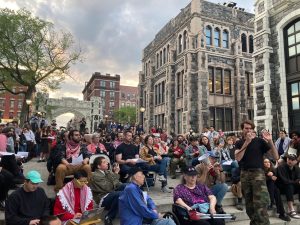This is the second of three articles by Anna Malyukova about her memories of the Soviet Union, where she grew up and lived before its collapse in 1989. Anna’s account is not a detached political analysis of the situation in the former Soviet Union but rather a story of her personal experiences, which illustrate the deep contradictions that marked the society and the everyday lives of the people.
The Russian Revolution has been subject to multiple misrepresentations, particularly in the United States. The anti-communist policies of successive U.S. administrations during the second half of the twentieth century made it possible for socialism to be identified with totalitarianism, oppression, and lack of freedoms. American capitalism, by contrast, has presented itself as the best possible social system. However, after eight years of economic recession and after the election of Donald Trump, things seem to be changing.
People across the world, including in the United States, know that capitalism is a system that deserves to die. The most sinister face of the “American way of life” is the exploitation and precarization of millions of workers, the rampant police violence, systemic racism, the mass incarceration of America’s Black population, and the persecution of immigrant workers. Globalization has enabled American transnationals to enrich themselves by exploiting millions of workers, while oppressed people everywhere, especially in the Global South, suffer under the yoke that is the criminal economic and political hegemony of the US — the superpower that is sometimes commanded by Democrats and sometimes by Republicans.
In this context, it is useful to shed some light on what was the most impressive working-class revolution in history. It is true that the Communist Party was the main agent of capitalist restoration in Russia; however, some of the achievements of the Revolution endured into the 1980s, such as access to education, healthcare, and recreation. These important public goods and services, which are effectively withheld from millions of workers in the US, in particular from people of color and Latinx, were a lasting feature of Soviet society, and this was possible only because the revolution had expropriated the capitalist class. The laboring masses had taken their destiny into their own hands by taking political power and
making the means of production the property of the state.
While the Russian Revolution of 1917 remains a most impressive testament to the profound changes that the working class is capable of bringing about, the subsequent developments in the Soviet Union are evidence of the nefarious role of the Stalinist bureaucracy, which used the theory of “Socialism in one country” in order to isolate the country in the world. As a result of the Stalinist counter-revolution, revolutionary movements all around the world were stopped in their tracks, as socialism was supposed to exist in “peaceful coexistence” with imperialism.
There are profound lessons to learn from the Bolshevik revolution. First and foremost among these lessons is the fact that a society without capitalist exploitation is possible. This is of immense importance especially for new generations of workers and young people who begin to embrace the idea of socialism and are looking to study the history of the Russian Revolution and of the Soviet Union in order to understand better how to build revolutionary movements that are prepared to take up the fight against global capitalism today.
***************************************************************************
You can read the first part of Anna’s narrative here
I was a healthy child, which was a relief for my parents. Mothers are given 18 months of maternity leave, while receiving half of their salary, and another 18 months with a quarter pay, if they decide to stay at home longer. Most women returned to work after 18 months, because the state provided daycare facilities for very little pay. Stay at home mothers were a rarity. Homeschooled children were even a bigger rarity. Most adults worked and unemployment was virtually nonexistent. To not have a job was synonymous with being useless to the state and everyone wanted to be useful to the state and participate in the economy. Cultural capital played a tremendous role in social life when finding a job of finding the right health specialist. Corruption did exist, but the scale of it is modest compared to what it seems to be now.
Early childhood education was very structured and very traditional. We were brought up to follow the footsteps of young Vladimir Ulyanov, who is known to the world as Lenin, learning stories about him from the time we were toddlers. Children prepared regular performances for adults, where they presented perfectly memorized lines and sang songs in choirs in perfect synchrony. Creativity was not nurtured in us and often seen as something devious, at least in my experience. But we were provided a great preparation for schooling and, most importantly, it allowed both of our parents to work full time and not worry about providing care for us. I always hated daycare and talked a few kids into digging under the fence to run away from the center (my building was right across the road from the daycare). Unfortunately, we never actually got to do it. What I liked was to stay home with my mom and play the way I wanted, which was mostly by myself. There, I could let my creativity take any shape I wanted.
Each building had a little playground for children with swings, slides, and a sandbox. In the afternoon most kids were there, playing, with adults overseeing them as they sat on the benches in front of the buildings. Our neighborhood was very clean because on Saturdays everyone got together for a Subotnik — event when everyone collected garbage and cleaned up the neighborhood. It was a fun event with a big fire of collected sticks and paper garbage at the end of the day, burning in the dark. Adults were usually signing, drinking was usually involved, and children running around, playing.
You may be interested in: Education in the Soviet Union
There were plenty of stores in my hometown, but the shelves were never full of items. My parents often took a 5 hour trip to Moscow on a train to get some groceries and delicatessens like cured meats, bananas, oranges, etc. Now, when I go shopping at Costco (or even a local grocery store) I often come back with bags and bags of food, only to go back to a supermarket in a day or two, when my parents came back with less stuff from the capital of Russia back in 1980s. There was a dry cleaning store and a hair salon in the next building form us. My parents would visited the hair salon regularly, but dry cleaning was a luxury for us. Most people owned washing machines, as did we, and the clothes would dry in special fenced up areas next to the buildings. On a sunny day, women would hang their bedding and towels to dry up in the sun. Small items will dry up in apartments or on balconies. Nowadays these spaces are used for parking, but back in the day, you can find women hanging clothes in the sun, kids playing in the sandboxes, riding bikes around the building, trees, flowers, and bushes surrounding the neighborhood, cats taking their walks, dogs warming up in the sun, men playing dominoes and smoking.
I realize that this image is romanticized by the memories of my childhood, but this is how I remember my life in a small provincial town in a classless Soviet Union. It was more of a community then than it is now in Russia, where capitalism replaced group consciousness with individualism and competition for resources and jobs. People didn’t have much, but enough to live a respectable life. And everyone was pretty much in the same boat. I believe that all these benefits are due to the fact that the workers and the Russian people had a great revolution and as a product of it, they achieved great conquests that today do not exist in capitalist countries, for example, in the United States where education and health care are for a few.
At the same time, as I said at the beginning, there were social inequalities as well. It had a lot to do with who you knew and that often meant belonging to the Communist Party, which by the time I was born, was corrupted as well. Once you were well connected, it provided you with additional income, often in terms of bribes, as well as opportunities to have access to luxurious items which gave you other options to make money or use them as bribes.
One thing that as a child then and as a parent now I find amazing is that Soviet Union had in place a structure to help families and children to have extracurricular activities and after-school programs. Each state agency or factory had a cultural center, where concerts, political and social events took place, but it also had free programs for children. There were dance, art, drama, circus, and any kind of sport classes set up in those centers. Some were better than others, but every child had access to them. My parents enrolled me in a music school outside of those centers, which I attended for seven years and that was an intense experience where I attended classes four days a week, and this was something that we had to pay for. That was probably true about any activity if one wanted to get really good at something — music, gymnastic or anything else — find private schools or tutors. However, to find free after-school activities for you child and allow them to try and find for themselves what may be interesting to them, was quite easy.
My parents lived half of their lives under the communist regime and reaped benefits from a lot of social structures and systems set up by the state. It was a stable time, when one knew what to expect from the next day. When Soviet Union collapsed, life as we knew it ended and stability was gone. With the stability a lot of benefits of the socialistic country vanished as well. In the United States, people have heard of the bad things about the Soviet Union. Some are real and some have to do with the “war against communism” that worried U.S. capitalism so much. I think one of the bad things is precisely that there existed this privileged sector, a caste. However, what was great is often overlooked. This is, along with the huge social progresses in the Soviet Union, is a compelling lesson which must be learned.


